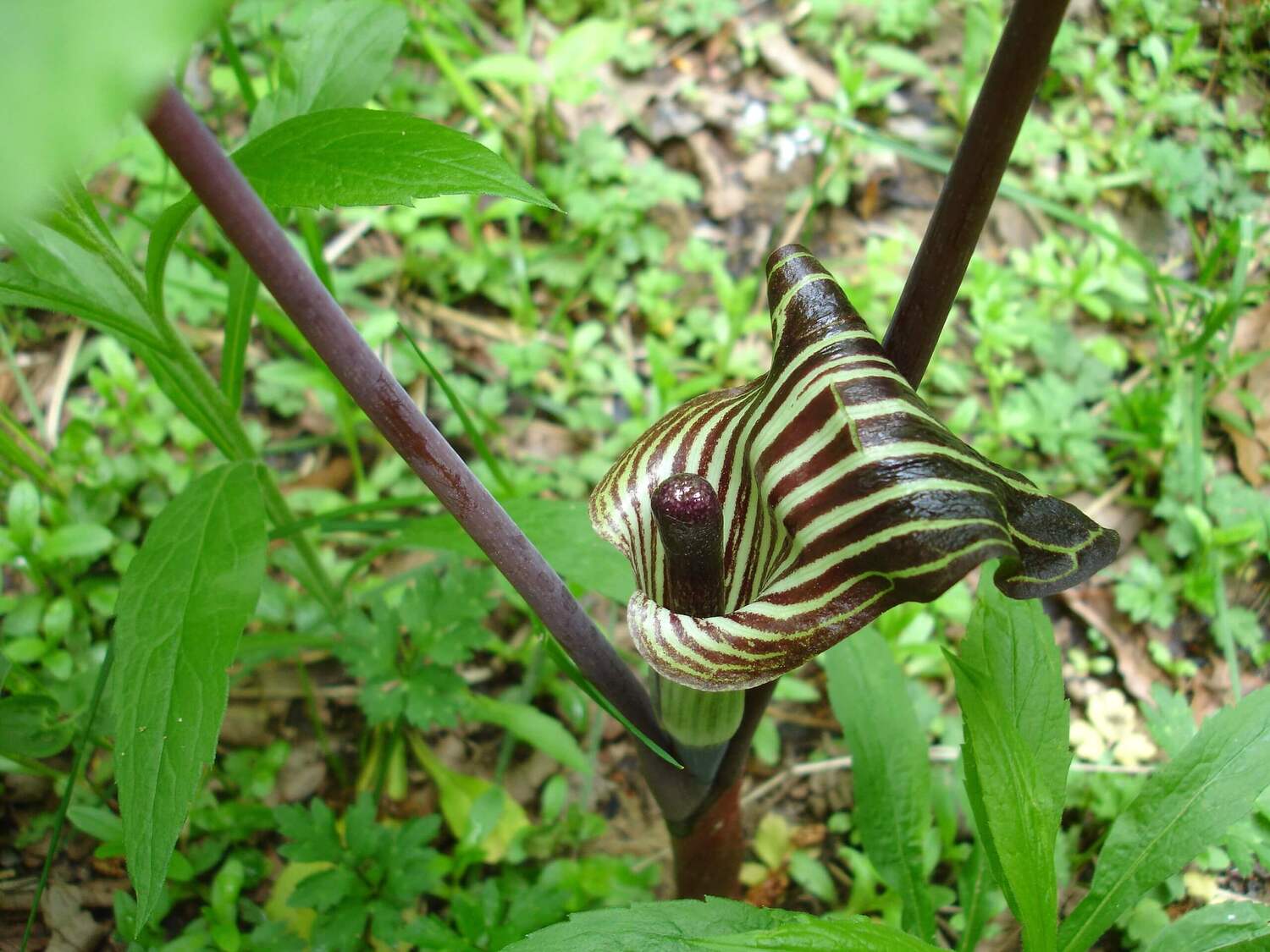
Jack-in-the-Pulpit, scientifically known as Arisaema triphyllum, is a fascinating and unique plant that can be found in the woodlands and shady areas of North America. This conspicuous herbaceous perennial is known for its distinctive appearance, with a spadix that resembles a preacher in a pulpit, hence its common name. While Jack-in-the-Pulpit may be a familiar sight to some, there are many mind-blowing facts about this plant that are sure to captivate even the most seasoned plant enthusiasts. From its intricate reproductive system to its historical uses in indigenous cultures, Jack-in-the-Pulpit has a rich and intriguing story to tell. In this article, we will explore nine mind-blowing facts about Jack-in-the-Pulpit, shedding light on the remarkable characteristics and contributions of this remarkable plant.
Key Takeaways:
- Jack-in-the-Pulpit is a fascinating plant that can change its gender, live up to 100 years, and has a unique flower structure that attracts pollinators with a scent resembling decay.
- Native to North America, Jack-in-the-Pulpit has a rich history of traditional medicinal uses by Native Americans and is toxic if ingested, making it important to handle with care.
Origins and Name
Did you know that the Jack-in-the-Pulpit plant, scientifically known as Arisaema triphyllum, is native to the eastern regions of North America? The name “Jack-in-the-Pulpit” comes from its unique flower structure, which resembles a little person, or “Jack,” standing in a pulpit.
A Gender-Bending Plant
Jack-in-the-Pulpit is a fascinating plant because it has the ability to change its gender. In the early years, the plant starts as a male, but as it matures, it can switch to becoming a female. This unique trait ensures cross-pollination and increases the plant’s chances of reproduction.
The Hooded Flower
The flower of Jack-in-the-Pulpit is truly remarkable. It consists of a greenish-purple spathe that wraps around a central stalk, known as the spadix. The spathe acts as a hood, protecting the tiny flowers beneath it. This arrangement helps to attract pollinators and provides a safe haven for the plant’s reproductive process.
The Scent That Attracts Pollinators
To attract its pollinators, Jack-in-the-Pulpit emits a subtle yet distinctive scent that is reminiscent of decay. This odor attracts insects like flies and beetles, which play a crucial role in pollinating the plant. It’s amazing how nature has its way of using unique mechanisms to ensure the survival of different species.
A Long-Lived Plant
Jack-in-the-Pulpit is known for its impressive lifespan. With proper care and favorable environmental conditions, this plant can thrive for up to 100 years! Its longevity makes it a symbol of resilience and strength in the world of flora.
Traditional Medicinal Uses
The Native Americans have a long history of using Jack-in-the-Pulpit for medicinal purposes. They utilized various parts of the plant, such as the corms and the roots, to treat ailments like inflammation, snakebites, and respiratory issues. Modern medicine has yet to tap into the full potential of this remarkable plant.
Toxicity Warning
While Jack-in-the-Pulpit has fascinating attributes, it’s important to note that the plant is toxic if ingested. It contains calcium oxalate crystals that can cause severe irritation and discomfort. Therefore, it’s crucial to handle this plant with care and keep it away from curious pets and children.
Jack-in-the-Pulpit in Art and Literature
Throughout history, Jack-in-the-Pulpit has inspired artists and writers with its unique form. It has made appearances in various paintings, illustrations, and even children’s stories. Its distinctive shape and captivating colors make it a favorite subject for many creative minds.
The Power of Jack-in-the-Pulpit in Gardens
In addition to its natural habitats, Jack-in-the-Pulpit also thrives in well-maintained gardens. Its stunning appearance and ability to adapt to shade make it a popular choice among garden enthusiasts. Adding this plant to your garden can bring a touch of elegance and a sense of wonder to your outdoor space.
Conclusion
Jack-in-the-Pulpit is a fascinating and unique plant that captivates both plant enthusiasts and nature lovers alike. Its distinctive appearance, intriguing life cycle, and cultural significance make it a truly mind-blowing species. From its unusual flower structure to its ability to change its sex, Jack-in-the-Pulpit never fails to amaze. So, the next time you come across this intriguing plant in the wild, take a moment to appreciate its beauty and the secrets it holds.
FAQs
Q: What is the scientific name of Jack-in-the-Pulpit?
A: The scientific name of Jack-in-the-Pulpit is Arisaema triphyllum.
Q: Does Jack-in-the-Pulpit have any medicinal uses?
A: Yes, various indigenous tribes have used different parts of the plant for medicinal purposes such as treating digestive disorders and skin conditions.
Q: Is Jack-in-the-Pulpit a common plant?
A: Jack-in-the-Pulpit is relatively common in wooded areas of North America, particularly in the eastern and central regions.
Q: Can Jack-in-the-Pulpit be grown in a home garden?
A: Yes, with the right conditions, Jack-in-the-Pulpit can be successfully grown in a home garden. However, it requires shade, moist soil, and a suitable climate to thrive.
Q: Why is it called Jack-in-the-Pulpit?
A: The common name, Jack-in-the-Pulpit, refers to the unique flower structure. The spathe (the pulpit) surrounds and protects the spadix (Jack), resembling a preacher in a pulpit.
Q: Are all Jack-in-the-Pulpit plants green?
A: No, while the majority of Jack-in-the-Pulpit plants have green spathe, there are variations where the spathe can be striped or even entirely reddish-purple.
Q: How long does it take for Jack-in-the-Pulpit to reproduce?
A: It can take several years for Jack-in-the-Pulpit to reach maturity and start producing flowers. Once pollinated, it produces a cluster of bright red berries that contain seeds.
Q: Can Jack-in-the-Pulpit be found outside of North America?
A: No, Jack-in-the-Pulpit is native to North America and is primarily found in the United States and Canada.
Q: Is Jack-in-the-Pulpit poisonous?
A: While Jack-in-the-Pulpit does contain calcium oxalate crystals that can cause irritation if consumed, the plant is not considered highly toxic and is typically avoided by animals due to its pungent taste.
Exploring nature's wonders doesn't stop with Jack-in-the-Pulpit. Dive into the colorful world of wildflowers, each with its own unique story to tell. Discover the fascinating native plants like the Compass Plant, a natural navigator that points the way. Uncover the captivating beauty of perennial plants such as Hepatica, a resilient flower that thrives in the harshest conditions. Embark on a journey through the plant kingdom, where every species holds a treasure trove of secrets waiting to be revealed.
Was this page helpful?
Our commitment to delivering trustworthy and engaging content is at the heart of what we do. Each fact on our site is contributed by real users like you, bringing a wealth of diverse insights and information. To ensure the highest standards of accuracy and reliability, our dedicated editors meticulously review each submission. This process guarantees that the facts we share are not only fascinating but also credible. Trust in our commitment to quality and authenticity as you explore and learn with us.


